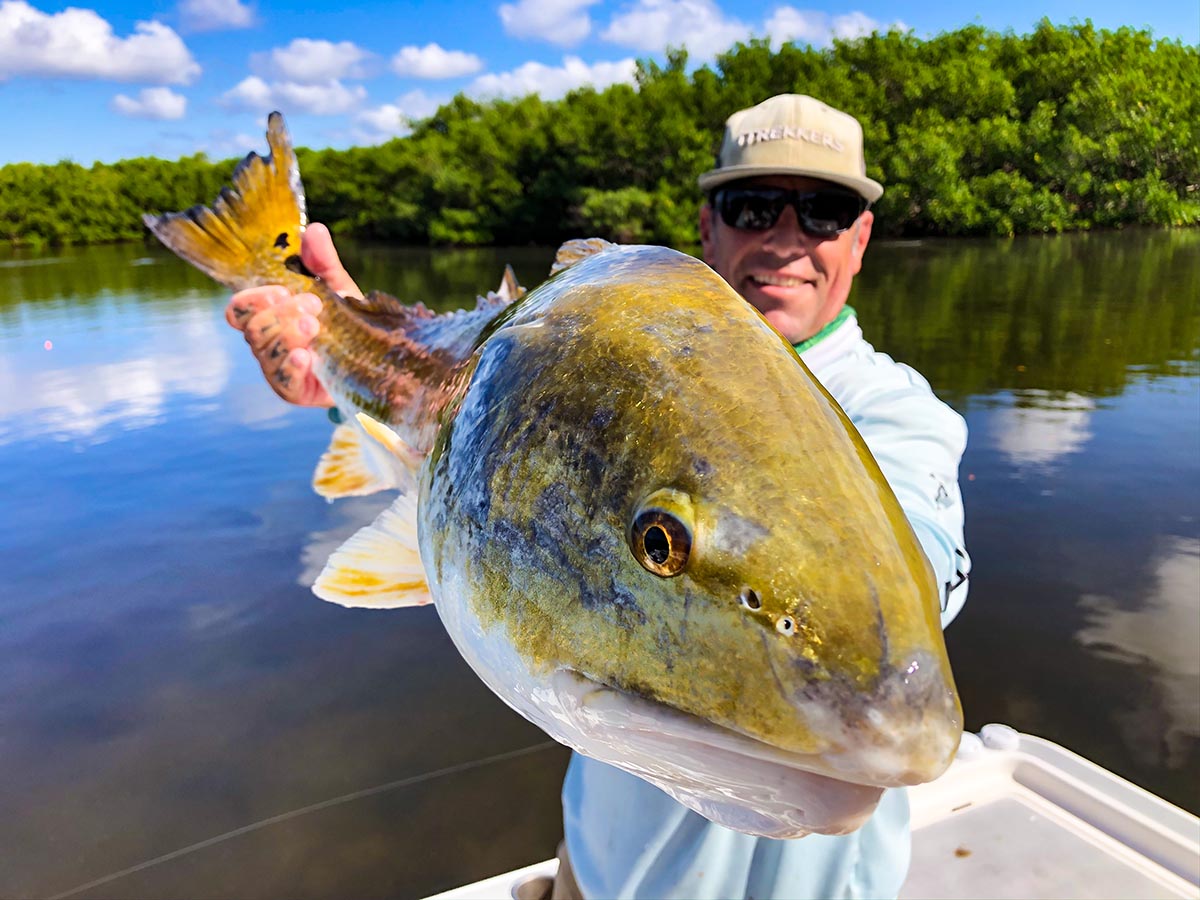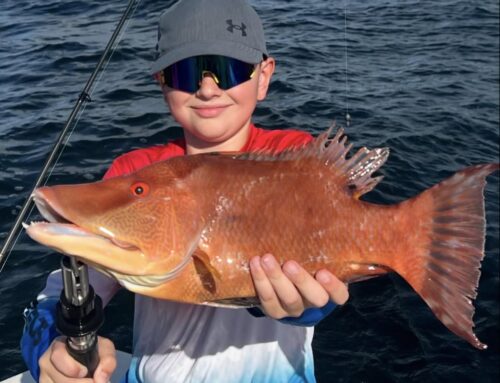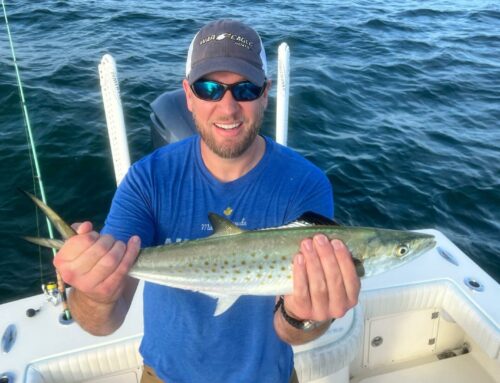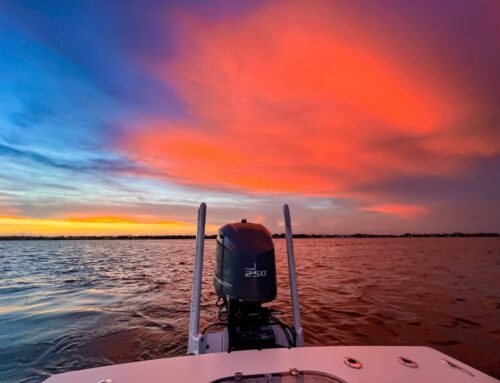Last Updated on November 25, 2025 by Writer
The shallow reefs off Anna Maria have been lit up all week. Clean water, good current, and plenty of bait have the nearshore stuff chewing like they’re making up for lost time. Mangrove snapper, red grouper, hogfish—you drop something down in 20 to 40 feet right now, it doesn’t sit long.
That’s the kind of stretch that gets people thinking the bite will stay like this forever, but as we slide out of late fall and into December, you’ll see the water cool a touch, the bait thin out, and the fish spread or bunch depending on how hard those first fronts hit. January can be a whole different deal — calmer days feel colder, the fish tuck in tighter, and you’ve got to pay more attention to where the warmer pockets are sitting.
Winter around Anna Maria Island doesn’t change the inshore fishing so much as it shifts everything a little to the side. Anyone who’s experienced enough seasons out here knows the pattern: the last fall cold fronts roll through, the water clears up, the boat traffic thins out, and the fish start bunching in the places that hold the most steady temperature. (Nearshore still fires plenty in winter, but you start noticing how the action moves. The reefs that were hot all week might quiet down after a cold snap, and the ones nobody talked about in November suddenly turn on.)
That’s just how fishing Anna Maria Island works. If you know what changes and when, you stay ahead of it. If you don’t, it feels like the Gulf shut off overnight. Reds usually slide onto the shallower edges once the sun stays on them for a bit. Trout settle deeper until the water bumps up a degree or two. Snook back into creeks and canals where the cold doesn’t hit as hard. Sheepshead stick to their usual pilings and dock legs and chew on the barnacles like they always do in winter.
People new to winter fishing in AMI think everything shuts off as soon as the temperature drops, but it doesn’t work like that here. The bite keeps going if you adjust how you look at the water. Slow your retrieve, check the darker bottom areas that warm faster, and pay attention to where the wind is pushing cleaner or dirtier water. The small details make the difference between covering dead water and staying on steady fish.
How Cooler Weather Shapes the Bite
Cold water calls the shots in winter. You can talk tides, moon phases, barometer, whatever, but once that temp drops, the fish only care about places that don’t chill them to the bone.
Every move they make this time of year comes back to that number on the thermometer. As soon as the Gulf of America cools off, fish begin stacking into places that trap warmth and food. The back reaches of mangrove shorelines, muddy-bottom troughs near oyster beds, and shallow flats that hold sun through the afternoon all turn into steady producers.
Small bumps in temperature—like just a degree or two—can change fish activity levels, especially after runs of colder nights.

Now all that being said… your presentation needs to match that slower pace. Fish conserve energy in cooler water, so they respond better to baits that move naturally and stay in the strike zone longer. Long drifts, slow hops, and subtle movements do more work than fast pops or aggressive retrieves. That goes doubly true because the water itself looks different this time of year. With fewer plankton blooms, visibility increases. Clear water makes it easier to spot fish sliding along the flats or easing around structure, but it also means they pick up on shadows, noises, and pressure changes much faster.
Sloppy boat handling ruins good water faster in winter than in summer.
A lot of fishermen on the waters around Anna Maria Island switch to lighter leaders and longer casts simply because fish react better when something approaches from a distance.
Wind, Tides, and Water Clarity
Winter usually comes with more wind, and where it blows from decides what parts of the island are worth fishing. An offshore wind flattens the inside waters, so the mangroves and grass flats get cleaner edges and easier casts.
If you get a morning tide with a little sun on it, the shallows warm enough to pull fish up, especially on dark bottom where the heat holds longer. Folks who pay attention to those windows—wind, sun, tide—stay on fish even when the water feels cold.
Fewer boats on the water give you more room to work a shoreline slowly and see how fish set up in it. That lack of traffic helps you notice things you overlook in summer—mud puffs from feeding reds rooting around, trout scattered across a flat instead of balled up, or sheepshead easing along pilings picking at barnacles.
Winter water clears up too, and that cuts both ways. You can see bottom contours more easily, which makes it simple to pick out sandy potholes, depressions, and feeding lanes. At the same time, fish react to boats and movement more quickly. Spotting a redfish tailing from 30 yards away sounds good, until it bolts because your shadow hit the water wrong. Long leaders, natural colors, and a low-profile approach make a noticeable difference.
If your first cast lands right, you’re much more likely to get bit. If it doesn’t, that fish is usually gone.
The Big Advantage of AMI Inshore Fishing in Winter
One of the underrated benefits of winter on Anna Maria Island is the space it gives you. Captains, AMI fishing guides, and other locals talk about it every year—the whole coastline feels calmer.
With fewer boats running around, you can slide up to a mangrove point and actually work it without three other hulls drifting over your line. You can test a drift, see how your bait rides the tide, or check how far reds push up when the sun warms the bank. It’s also a good time to poke around spots you avoid in busy months because you finally get them to yourself.
Winter Target Species
When the water cools around Anna Maria Island, the fish settle into patterns that stay pretty stable from week to week. When you’ve been fishing in AMI through a couple winters, you start to recognize where our local species like to tuck in, and what gets them moving.
Redfish

Reds hold their weight in winter because they stay active even on colder mornings. You’ll find redfish schooling on shallow flats that warm a little quicker, or cruising the edges of mangroves once the sun comes up.
Shrimp works everywhere this time of year, and soft plastics with a slow, steady motion get picked up when the fish aren’t chasing much. Watch for dark bottom areas—they hold heat, and the reds seem to know it.
Spotted Seatrout

Trout settle into deeper grass flats, troughs, and the shaded cuts between flats and channels. They’ll push a little shallower once things warm, but not by much.
A jig with a light head dropped into the deeper spots does most of the work. Live shrimp or a popping cork rig still catch plenty, especially when trout rise higher in the water column around midday.
Snook
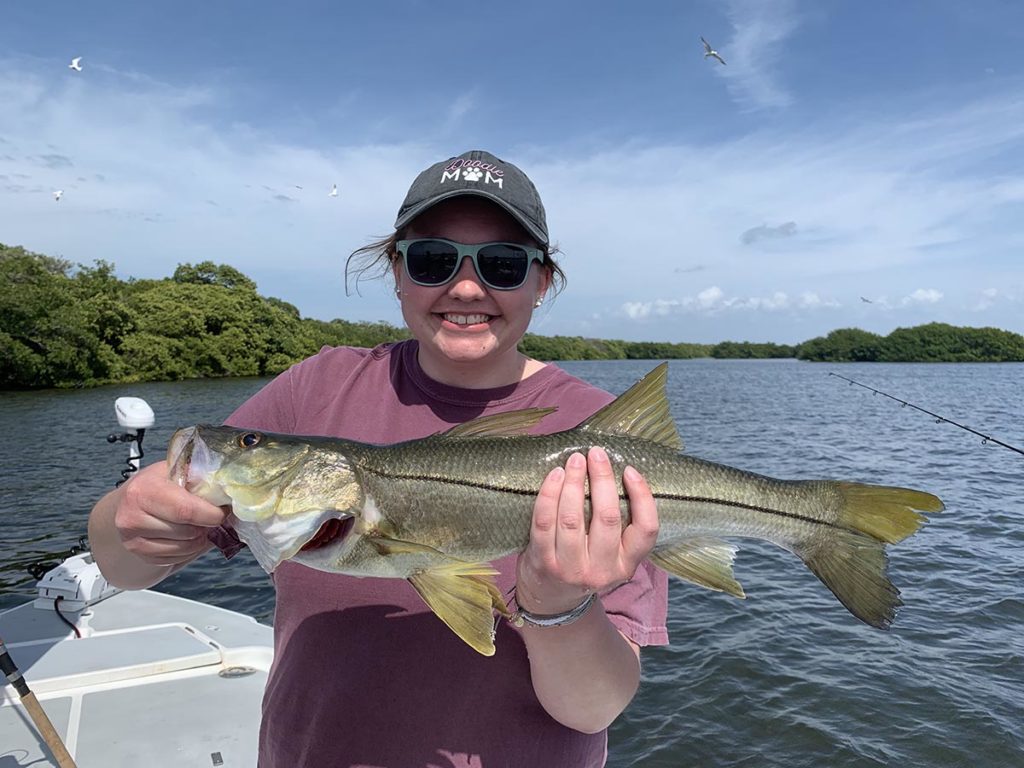
Snook take the cold personally. Once water temps really dip, they push back into creeks, canals, and the deeper turns under mangroves. You won’t find them spread out like in summer.
You’re basically looking for pockets that hold a few degrees more warmth. Whitebait or finger mullet fished slowly—almost lazy—can still pull a strike from a snook that isn’t in a chasing mood. They’re more cooperative after two or three warm afternoons in a row.
Sheepshead
Winter is prime time for sheepshead fishing in AMI. They stick to anything covered in barnacles—docks, seawalls, piers, pilings, oyster bars. They’re picky eaters but reliable: fiddler crabs, barnacles scraped loose, small shrimp. The trick isn’t finding them so much as it is setting the hook before they spit you out. Most AMI locals give their line a touch of tension, watch the rod tip, and commit early.

Different species respond to the cold in their own way, so changing up your bait or your retrieve based on how the fish act that day usually matters more than whatever the forecast says. One day reds want slow-moving plastics. The next day trout light up for a popping cork.
Where to Find Fish in Winter
Anna Maria Island has plenty of productive water year-round, but winter narrows things down. Fish start bunching up in places that offer a mix of warmth, food, and protection from the wind.
Grass Flats
Shallow grass flats warm quickly once the sun gets up. Reds and trout move onto these flats to feed, especially around potholes and sandy pockets. If you can see dark-bottom flats on a sunny afternoon, it’s worth drifting them slowly.
Mangrove Lines and Creeks
Snook and reds use mangroves like a wall. Even a foot or two of depth under the edge can hold fish. On colder mornings, creeks that snake behind the island can be surprisingly productive—the water sits still and warms a little faster than open flats.
Bridges and Piers
The Sunshine Skyway area and the local piers produce steady winter fish, especially sheepshead. Barnacles, shade, and moving current keep life around the pilings. You’ll also see snapper and the occasional grouper hold in these same areas.
Channels and Drop-Offs
When shallow water cools too much, trout and reds fall into the nearest deeper stretch. The edges where a flat breaks into a channel often hold fish throughout the day. A slow jig on the bottom or a shrimp drifted naturally through the cut usually gets their attention.
Using tide charts helps a lot in winter. Around this island, fish move differently on a warming incoming tide versus a cold outgoing tide.
Winter Gear & Tackle Tips
Rod and Reel
A medium-light spinning setup with a 2500–3000 reel covers almost everything you’ll hook inshore this time of year. A smooth drag helps when trout or reds take a fast sideways run.
Line and Leader
Most people run 10–15 lb braided line with a 20–30 lb fluorocarbon leader. Winter water is clear enough that a slightly longer leader pays off. You’ll notice the difference around spooky reds and snook.
Baits and Lures
Live shrimp is the universal winter bait here. It catches everything from trout to sheepshead. For artificials, soft plastic jigs and suspending twitch baits match the slower winter mood. Smaller spoons still work, but they’re better on days when the water warms enough for fish to chase.
Clothing and Essentials
Winter mornings can feel colder than they look. Dress in layers you can peel off by lunch if you need to. Good polarized sunglasses are almost mandatory in the winter glare, especially if you’re sight fishing. Waterproof boots help when the deck or shoreline stays damp.
A cast net is handy, and most local fishermen keep one in the truck or boat out of habit. When baitfish push into canals or warm pockets, it saves time and money to grab your own instead of hoping a bait shop has inventory on a cold morning.
Strategies for Better Fishing in Winter
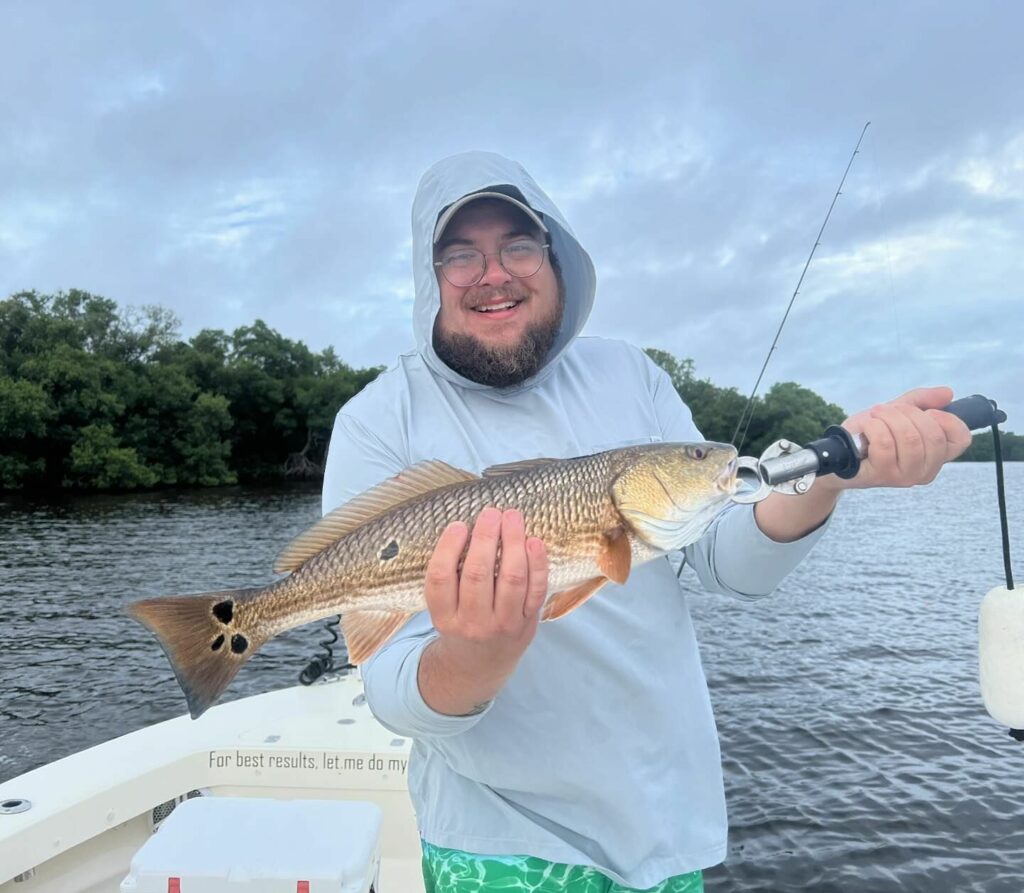
Winter fishing on Anna Maria isn’t too hard, but it does punish bad habits. If you adjust your approach, you’ll stay on fish. If you don’t, you’ll spend your morning wondering why everyone else is hooked up.
Slow Down
Cold water makes fish lazy. That said, if the sun warms a flat 2 or 3 degrees in the afternoon, reds will still crush a bait. Trout can get aggressive in deeper grass pockets, and snook will hit if you drop something right in front of them.
Fishing Anna Maria Island in winter, you want to work your baits slower than you think you need to. Jigs, shrimp, soft plastics—doesn’t matter. They aren’t going to run something down from a long way away, so give them an easy shot at it. If you’re ripping anything across the bottom in January, you’re wasting time.
Pick the Right Part of the Day
Mid-morning through early afternoon usually beats first light in winter. The water needs a little sun before anything starts moving. On warm, bright days, the bite can pick up fast once the flats heat a few degrees.
Fish Structure
Mangroves, docks, oyster beds, bridge pilings—everything piles up around structure in winter. Reds tuck tight to the edges, snook fall back into the deeper pockets, and sheepshead stay glued to anything covered in barnacles. If you aren’t getting bit, get closer to the structure.
Stay Quiet
Winter water is clear. Fish can see you, hear you, and feel you. Long casts and clean approaches matter. Don’t slam hatches, don’t let your shadow fall across a flat, and don’t drift right over a school expecting them to stay put.
Watch the Birds
Gulls and terns diving on bait in winter tell you exactly where the life is. Even if the fish underneath aren’t going wild, bait in the area usually means trout or reds aren’t far. Most fishermen overlook this because they associate bird activity with summer. It still matters in January.
Change Your Retrieve Based on Conditions
Cold, still mornings: drag a jig along the bottom with small hops.
Warmer afternoons: twitch baits and faster retrieves start waking fish up.
If you try to fish the same way all day, you’ll miss the window.
Conservation/Responsible Fishing
Winter puts more pressure on fish because they bunch up in predictable spots.
- Follow the size limits and bag limits. They exist for a reason.
- Use wet hands or a net if you’re releasing fish.
- Don’t crowd someone already working a shoreline.
- Clean up your bait cups, line scraps, and cans. Nobody wants to fish behind a slob.
- Don’t tear up grass flats by running your boat too shallow.
A lot of the winter action happens in tighter spaces—creeks, mangrove pockets, canal mouths—so respect and patience go a long way.
Final Thoughts

Winter fishing around AMI comes down to keeping an eye on depth, water temp, and how fast you’re working your bait. When the water cools off, fish slide into the spots that make sense for them, and they’ll eat if you match their pace. Move slow, fish steady, and hit the right windows. That’s usually all it takes to stay on them.
If you’d rather let someone else handle the tides, bait, and picking the spots that are holding fish, Captain Nate’s your guy. He’s out here every day and keeps up with how the reds, trout, snook, and sheepshead shift around once winter settles in. If you want a great day on the water with someone who knows these creeks and flats inside and out, he’ll put you on the right water. Click here to reserve your trip with Captain Nate.

